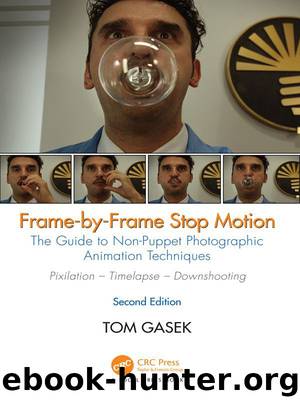Frame-By-Frame Stop Motion: The Guide to Non-Puppet Photographic Animation Techniques, Second Edition by Tom Gasek

Author:Tom Gasek [Gasek, Tom]
Language: eng
Format: azw3
ISBN: 9781351641692
Publisher: CRC Press
Published: 2017-05-19T04:00:00+00:00
Figure 7.10
Three methods of cutout hinging (rivet, wire, and wax).
There are many more techniques for gaining control and hinging cutouts. It all depends on your ability to work under the animation stand, how patient you are, and what your style of work and animation is. As Evan Spiridellis puts it:
For cut paper animation we don’t use any hinges. It’s a bit more frustrating and time consuming to work this way but it allows a lot more flexibility in the poses and keeps the animators from tightening up. If we are working with paper-puppets we’ll use anything we can twist into a circle as a hinge. Sometimes it’s wire, sometimes it’s a paperclip. It’s typically whatever is lying closest on the desk.
Evan Spiridellis
Two final pieces of advice from director and animator Terry Gilliam regarding cutouts:
The most important equipment was a sharp scalpel.
Make sure you blacken the edges [of the cutouts].
Terry Gilliam
Objects and cutouts can also be shot vertically as opposed to in a downshooting mode. Pictures can be mounted on glass or mounted sliders that hold the cardboard-backed cutouts upright. The camera would be mounted on a tripod in this case. The lighting arrangement is a little more flexible and tracking the cutouts becomes very manageable. Jim Blashfield, a contemporary independent artist and American Animation Master from Portland, Oregon, would often shoot objects vertically frame by frame and then cut out those photo images and reshoot the photographed images on a downshooter. Here he describes his approach to a music video he directed called And She Was for Dave Byrne and the Talking Heads in 1986. It was produced by Melissa Marsland.
All scenes were animated to the frame by frame log we had made of the song. That log was the backbone to the video, whether scenes were preplanned or improvised. Also central were the boxes of color Xeroxes that resulted from our guerrilla-photo-shoots all over Portland. We drove around looking for garage sales, second hand stores, interesting neighbourhoody things, and photographing them on site, along with personal items that seemed to fit in: A mailbox that looked just the right way, etc. For one overhead scene Don (Merkt) sent Melissa (Marsland) off to snatch a couple of pairs of my underwear from our house, the patterns of which appeared floating across the scene. We chose ordinary things that either we thought would be amusing, or/and which seemed to have embedded metaphorical power, or which we otherwise thought should be honored for their long and unappreciated contribution to our lives. Spatula, reclining chair, purse, party hat—icons from the less appreciated heights of our culture. We also carefully photographed our pixilated moving leg sequences, and others, one frame at a time, onto color slides, and these were cut out by a herd of our friends with X-acto knives, and put into the boxes in folders. The live action of David singing was 16mm footage which we shot in Dallas in our very minimal live action shoot—camera balanced on some videotape boxes in
Download
This site does not store any files on its server. We only index and link to content provided by other sites. Please contact the content providers to delete copyright contents if any and email us, we'll remove relevant links or contents immediately.
Shoot Sexy by Ryan Armbrust(17659)
Portrait Mastery in Black & White: Learn the Signature Style of a Legendary Photographer by Tim Kelly(16953)
Adobe Camera Raw For Digital Photographers Only by Rob Sheppard(16906)
Photographically Speaking: A Deeper Look at Creating Stronger Images (Eva Spring's Library) by David duChemin(16623)
Bombshells: Glamour Girls of a Lifetime by Sullivan Steve(13977)
Art Nude Photography Explained: How to Photograph and Understand Great Art Nude Images by Simon Walden(12975)
Perfect Rhythm by Jae(5326)
Pillow Thoughts by Courtney Peppernell(4211)
The Book of Joy by Dalai Lama(3903)
Good by S. Walden(3489)
The Pixar Touch by David A. Price(3364)
A Dictionary of Sociology by Unknown(3031)
Fantastic Beasts: The Crimes of Grindelwald by J. K. Rowling(2995)
Humans of New York by Brandon Stanton(2835)
Stacked Decks by The Rotenberg Collection(2812)
Read This If You Want to Take Great Photographs by Carroll Henry(2664)
On Photography by Susan Sontag(2576)
Insomniac City by Bill Hayes(2499)
Photographic Guide to the Birds of Indonesia by Strange Morten;(2490)
